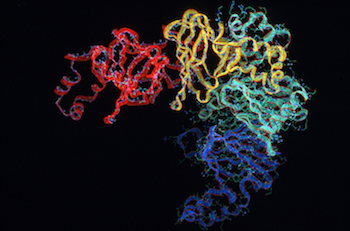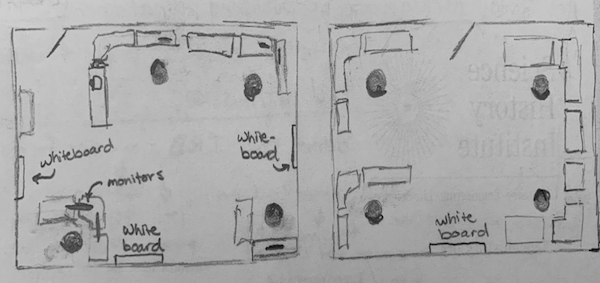Heading into Steve’s[1] university laboratory for the first time, I anxiously waited to begin observing the lab members’ work with computational protein structure prediction and design. This lab was one of the first spaces for such work in the US. Gaining legitimacy and recognition after the rise of genomics, protein computation aims to model protein structure and its interactions with other proteins, enzymes, and surroundings. This has become crucial for biological, biochemical, and even medical research. Needless to say, I was excited to see leaders in the field hard at work, but then was shocked to walk into a plain, tan-colored office area with four separate desks, everything completely quiet.
Because of their collaborative work with other research projects, I had expected to see a more vibrant and dynamic lab space. Sadly, my excitement and energy slowly dissolved away into boredom watching four students type code into their computers. As I observed lab members code and model proteins, I wanted to understand how so much excitement and a strong collaborative environment with outside sciences could come from such mundane computer work.
Throughout this post, I recognize how the dynamics of the group’s computational research in both physical and virtual spaces later becomes challenged by the closure of the lab space due to physical distancing protocols of the COVID-19 pandemic. Although research continues in the virtual space, Steve’s lab actually portrays the importance to these scientists of combining both the physical social interactions with the larger virtual world. The community created around protein computation transcends the isolated nature of working on a computer to encourage the construction of the tools for future bioscientific research.

Protein computational modeling. Source: https://www.scienceimage.csiro.au/tag/modelling/i/2589/shape-of-protein-backbone/large.
SRC and the Commons
Partnering with multiple Principal Investigators (PIs) and lab groups across the world, Steve and his group have created a protein computation software I will call the SRC that allows anyone that uses the software to predict and design biomolecular structures. Similar to Steve’s lab, Natasha Meyers observes in her book, Rendering Life Molecular (2015), a protein computational lab that focuses on X-ray crystallography where they also focused on “[designing] better tools” (129) for outside scientists. Myers notes how such models “rend the world in particular ways: they pull, tear, and torque the world in some ways (if not others). In the process they shape how and what we come know about the stuff of life” (130). Because they can provide ample biological information, protein computational tools eventually play a larger role than anticipated in multiple research projects to provide an even greater foundation for biomolecular understanding.
Having the first computational lab in the department at an institution on the US East Coast, there were not many expectations for the physical space of the laboratory. Thus, Steve had only been given the bare bones for any computational work: desks and monitors. Early laboratory ethnographers Bruno Latour and Steve Woolgar emphasize in Laboratory Life (1979) that “we attach particular importance to the collection and description of observations of scientific activity obtained in a particular setting” (28). Based on the layout of the desks and the chairs, I never expected much interaction between the PhD students and the post-docs. On the contrary, as I spent more time in the office, I saw a different environment as more chatter and conversations began to spark and lab members would socialize more often. Later into the semester, members from other labs would come in to talk about their work, collaborate on new research ideas, or ask how SRC could help them. Therefore, I came to understand later that the success in Steve’s lab did not arise from the plain offices per se, but, rather, from an environment cultivated in collaboration and a strong community.

Rough sketch of the office layout by the author.
Striking a conversation with Paula, I asked her about working in Steve’s lab, and she spoke highly of him, others in the lab, and SRC, citing the large collaboration of scientists working together for one common goal. Because of the many partnerships in the group, the leaders working on the SRC software purposefully aimed to build a healthy community among their lab members to support one another. Paula had referred to the overall community of SRC users as “the Commons,”[2] where they would be in constant contact with lab members from across the globe to work on challenges or solve complicated problems. Moving away from the traditional science culture of hiding methodology,[3] the Commons had thus established a healthy community where lab members could feel safe sharing their personal code or working together to co-publish a scientific paper, knowing that they would get support in their methods rather than suffer from someone stealing their ideas.
Since the Commons worked across many different lab groups, virtual communication was necessary from the start, including virtual meetings, group chats, and online conferences. With the exception of bi-annual in-person conferences, the Commons thrived in this virtual world to build the essential tools for creating and expanding the SRC software. In his book, Coming of Age in Second Life, Tom Boellstorff (2015) conveys that “[what] makes these virtual worlds real is that relationships, romance, economic transactions, and community take place within them—in short, that they are places of human culture” (244). Likewise, the human connections within the Commons and Steve’s lab ensures that their virtual landscape provides a method for them to successfully work together. Although the researchers working on SRC mostly work in the virtual space, it is the culture and social milieu that allows for innovation and collaboration to thrive within the scientific community.
The Strike of COVID-19
Katie, another lab member, acknowledges that before COVID-19, her lab joked that they could do research anywhere. Now, they have to test that hypothesis. Notably, while most of the SRC community has the resources necessary to continue doing their research, the lack of social interactions in person has largely slowed down computational modeling. Contrary to their hypothesis, the virtual collaboration of the Commons, so significant in the creation of the SRC, could not fully replace the physical, social interactions needed for computational modeling. How could this be possible?
While working in the lab, Katie was able to visit lab members and have researchers from other lab groups visit her. That impromptu social milieu helped solve questions and tackle challenges in many different areas of research, even outside protein computation. Moreover, new ideas, predictions, or questions could be raised from a coffee break or bugging another lab member. In short, computational research advanced and improved through ordinary in-person social interactions. Although online coffee breaks seem to provide a much-needed pause in one’s schedule, many within the lab acknowledge how important it was for them to move past their computers and speak with people in a physical space. While SRC users have been able to continue their work, COVID-19 has exposed how scientific practices occur within social milieus that extend across both physical (however seemingly barren) and virtual spaces, even when the latter may seem more predominant.
Collaboration and Community within Computation
Transcending the physically isolated nature of the computational lab, collaboration, as seen in Steve’s lab, promoted a stronger research group and a more dynamic environment. When I attended their weekly lab meetings to discuss their work and current literature, I was fascinated when Steve compared the data mentioned in the presentation to other scientists and other papers. Steve was always quick to bring up the work of others and communicated with them in order to improve the methodology used by his own lab members. Introducing their analysis of scientific work, Latour and Woolgar (1979) emphasize how they avoid distinguishing the “social” and the “technical” aspects of science, in order to introduce how they work together to formulate scientific research (29). Moreover, they describe that this method focuses on “the social construction of scientific knowledge” that also “draws attention to the process by which scientists make sense of their observations” (32). Therefore, Steve’s tendency toward collaboration speaks to the strong “social” aspect of the “technically” isolated work in protein computation. Even he himself recognizes this strong push for collaboration in noting how his lab members have grown and the SRC has developed.
Ultimately, Steve’s lab and its collaborative practices via the SRC further anthropological understandings of scientific research. Because of the emphasis on social collaboration, the Commons becomes able to reach its goal of developing the SRC to support breakthroughs in medicine and the biosciences. I do not want to privilege the “social” aspects of the laboratory over the “technical” aspects of protein computation (Latour and Woolgar 1979), but rather show how the technical dynamics of protein computation co-produce a social environment for the lab and the Commons around the globe—an environment that results in what these scientists understand as better “technical” science. As the COVID-19 era has forced many to quickly pivot towards a new “normal,” Steve’s lab provides a useful example to think about how physical distancing methods shed light on the nature of scientific practices.
Notes
[1] Steve is a pseudonym and the names of all the other lab members were changed. The software and every other title of Steve’s work were given another name.
[2] I am using the phrase “the Commons” from a part of the real name. Interestingly, I noted how the sharing of resources and helping others in their personal projects actually support the common goal towards creating the SRC software. Thus, I argue that the use of the terminology “commons” seems appropriate.
[3] When speaking with members of Steve’s lab and other researchers, in general, they have always acknowledged a long-standing culture within scientific research of not sharing data or a useful methodological practice until after publication. Researchers rely heavily on publications of their work and worry that sharing a new method will lead to it being published by another person without the necessary credit.
References
Boellstorff, Tom. 2015. Coming of Age in Second Life: An Anthropologist Explores the Virtually Human. Princeton, NJ: Princeton University Press.
Latour, Bruno and Steve Woolgar. 1979. Laboratory Life: The Construction of Scientific Facts. Princeton, NJ: Princeton University Press.
Myers, Natasha. 2015. Rendering Life Molecular: Models, Modelers, and Excitable Matter. Durham, NC: Duke University Press.
